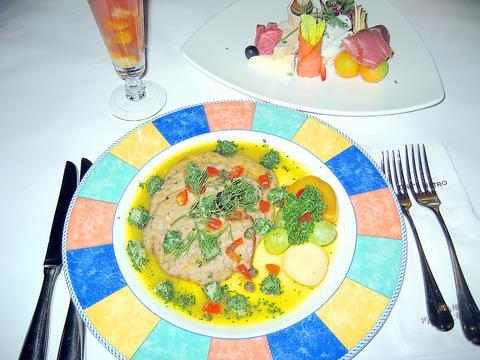Taipei's Tienmu expat community has had a trusty friend in the form of an American/Italian style eatery called Diamond Tony's since 1988. Designed to be part-bar, part up-scale restaurant, the joint is great for those looking to unwind after a day at the office, to wine and dine a special friend, or take their family at the weekends.
Building on the huge success of its long-standing Tienmu store, Tony's recently brought its popular diner downtown and opened a second branch in the burgeoning Taipei 101 Mall. Within three months of opening it has already proved a hit.

PHOTO: GAVIN PHIPPS, TAIPEI TIMES
Offering diners a tranquil and somewhat romantic atmosphere, with dim lighting, slick pinkish satin-covered furniture and with a constant hum of mellow lounge music in the air, the new Diamond Tony's is far removed from its lively Tienmu brethren.
The difference is only skin deep, however, as the menu is packed with all the same tasty appetizers (NT$180 to NT$420), seasonal salads (NT$200 to NT$280) and enticing entrees (NT$520 to NT$780) as the original store. One of the better ways to begin a meal at either branch of Diamond Tony's includes the deep fried squid with tartar sauce (NT$180), grilled calf tongue with spicy sauce (NT$260) and homemade liver pate (NT$240).
Served with more of an eye for haute cuisine when compared to some other Taipei American/Italian-styled diners where stodge is the order of the day, the entrees at Tony's both look and taste nice.
It's the homemade and reasonably priced pasta, gnocchi, penne and lasagne that are the biggest draws, however, with spinach, herb, pumpkin and squid ink pastas all available in various styles and with various sauces. Some of the more interesting include spinach pasta with smoke salmon, black pasta with squid and lemon sauce and herb pasta with lamb and pesto sauce.

Exceptions to the rule are sometimes revealing. For a brief few years, there was an emerging ideological split between the Democratic Progressive Party (DPP) and Chinese Nationalist Party (KMT) that appeared to be pushing the DPP in a direction that would be considered more liberal, and the KMT more conservative. In the previous column, “The KMT-DPP’s bureaucrat-led developmental state” (Dec. 11, page 12), we examined how Taiwan’s democratic system developed, and how both the two main parties largely accepted a similar consensus on how Taiwan should be run domestically and did not split along the left-right lines more familiar in

As I finally slid into the warm embrace of the hot, clifftop pool, it was a serene moment of reflection. The sound of the river reflected off the cave walls, the white of our camping lights reflected off the dark, shimmering surface of the water, and I reflected on how fortunate I was to be here. After all, the beautiful walk through narrow canyons that had brought us here had been inaccessible for five years — and will be again soon. The day had started at the Huisun Forest Area (惠蓀林場), at the end of Nantou County Route 80, north and east

Specialty sandwiches loaded with the contents of an entire charcuterie board, overflowing with sauces, creams and all manner of creative add-ons, is perhaps one of the biggest global food trends of this year. From London to New York, lines form down the block for mortadella, burrata, pistachio and more stuffed between slices of fresh sourdough, rye or focaccia. To try the trend in Taipei, Munchies Mafia is for sure the spot — could this be the best sandwich in town? Carlos from Spain and Sergio from Mexico opened this spot just seven months ago. The two met working in the

This month the government ordered a one-year block of Xiaohongshu (小紅書) or Rednote, a Chinese social media platform with more than 3 million users in Taiwan. The government pointed to widespread fraud activity on the platform, along with cybersecurity failures. Officials said that they had reached out to the company and asked it to change. However, they received no response. The pro-China parties, the Chinese Nationalist Party (KMT) and Taiwan People’s Party (TPP), immediately swung into action, denouncing the ban as an attack on free speech. This “free speech” claim was then echoed by the People’s Republic of China (PRC),